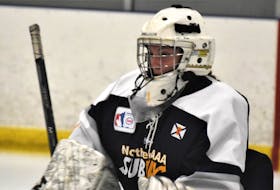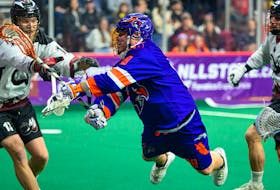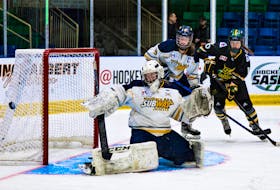In the summer of 2005, an exasperated Derm Dobbin, owner of the fledgling QMJHL franchise dubbed the St. John’s Fog Devils, stood on the steps of Mile One Centre in a hastily called news conference to protest what he perceived was the unreasonable treatment his brand, new hockey team was receiving from Mile One officials.
Dobbin ― who would later describe his relationship with Mile One as a “train wreck” and, “the worst case of a landlord and tenant relationship that I have ever experienced” ― wound up filing a grievance against those who pulled the strings with the rink, alleging a long list of violations in the Fog Devils’ lease agreement with St. John's Sports and Entertainment (SJSE).

Among his concerns, Dobbin maintained Mile One was inflating some charges, such as ticket-printing costs and access to St. John Ambulance services on game nights.
Those concerns were corroborated by Paul Boutilier, then president of the World Curling Players Association, who had brought the 2004 and ’05 Players Championship to Mile One.
In a scathing letter to then-Mayor Andy Wells, the provincial government and the SJSE board, Boutilier noted an invoice handed to him from Mile One saw the bill from St. John Ambulance had increased by 50 per cent from the original invoice given to Mile One for services rendered during the curling event.
“The blatant inclusion and mark-up by Mile One in the St. John Ambulance example leads to mistrust and an example of business practice that I'm sure an SJSE board member would not be proud of,” Boutilier wrote at the time.
“This makes all the other numbers in the closing document tainted, in our opinion.”
Boutilier also added, “I would describe the treatment of the World Curling Tour as one of disrespect (by Mile One Centre).”
In 2005, the Scotties Tournament of Hearts was held at St. John’s, and the relationship between Curling Canada and Mile One could best be described as frosty.
The now-retired Warren Hansen, the man who basically ran curling back in the day, privately groused that Curling Canada would never again return to Mile One (it did, of course, for the 2017 Tim Hortons Brier after Hansen’s retirement, and the event was a huge success, thanks entirely to Brad Gushue’s win).

The American Hockey League resurfaced in St. John’s in St. John’s in 2011, and with that brought another round of objections to Mile One’s pricey rental fees.
Danny Williams, the CEO of the new St. John’s IceCaps, grumbled the cost of his team’s lease agreement was “by far” the highest in the league, making it difficult to do business on a circuit where far-flung St. John’s was expected to pick up the travel tab from Toronto or Boston for teams coming to Mile One for games.
“There’s not even a possibility of getting another team if there isn’t 50 per cent relief in that rental fee,” he said.
“That has to happen. There’s no other way it can work.”
In the meantime, the relationship with the IceCaps, just as it had been with the Fog Devils, was, at best, chilly.
In 2017, Mile One was in the headlines again, this time for money that went missing from the building, cash to the tune of $58,089.
The money was never found, police were not called and hence no charges laid.
But citizens were assured by city hall and Mile One new measures were put in place to improve “numerous internal control weaknesses related to cash controls.”
And that was that.
So, you might ask, why would I be drumming up all this now?
Because when it comes to Mile One Centre and its clients, nothing ever seems to run smoothly or without animosity.
The Newfoundland Growlers are new to the game, barely a year old, but are quickly learning that when it comes to dealing with Mile One, things are rarely easy.
Last week, the city and SJSE, the board that runs the arena, announced they were concluding talks with the ownership groups of both the Growlers and NBL Canada’s St. John’s Edge regarding a takeover of operations of Mile One.
The three parties had signed a memorandum of understanding in March of 2018 that envisioned the Growlers/Edge owners managing the 18-year-old downtown building.
It comes down to this: SJSE says the idea was scrapped because a “proposal” from the two-groups-coming-together-as-one offered no reduction to the current subsidy provided to Mile One from city hall.
Dean MacDonald, who owns the Growlers, says no such “proposal” was forwarded. That’s because, he says, Mile One refused to provide basic financial information, which in turn made it near impossible to make any kind of computations without including the subsidy received last year from the city to the tune of $2,214,956.
So here we are again, another clash between Mile One and its existing client.
And what’s the common denominator?
Because when it comes to Mile One Centre and its clients, nothing ever seems to run smoothly or without animosity.
One of the issues is — and always has been — the idea of the subsidization of Mile One by the city. Truth is, Mile One has always been subsidized, just as Memorial Stadium was before that, and just as every other facility of its kind in every other municipality is across the country.
Here in St. John’s, the new Paul Reynolds Community Centre was subsidized in 2018 to the tune of $2,229,124 — $14,000 more than Mile One.
Both the Growlers and the Edge maintain they entered into an onerous lease with Mile One last year with the understanding that things would improve once they took over the building.
That appears to be out the window, and now we’re back to the hockey and basketball teams insisting Mile One’s rental rates are out of whack (the Edge, for example, are the model NBL Canada franchise, the league leaders in average attendance, but reportedly they're a money-losing operation, due in part, the team will argue, to its lease agreement with Mile One).
Does all of this sound familiar?
In 2017, The Telegram obtained a copy of Mile One’s rental rate card. A subsequent investigation revealed the St. John’s facility is the most expensive to rent in Atlantic Canada, more than Centre 200 in Sydney, N.S., and Harbour Station in Saint John, N.B.
More than even Scotiabank Centre in Halifax, the sports and entertainment hub in the Atlantic provinces.
There is a reason why Mile One’s calendar is devoid of entertainment, other than hockey, basketball and a scattered act here and there.
One of the reasons promoters won’t come here — other than obvious geographical challenges — is because the building, given its size, is too expensive to rent.
The Telegram’s probe back in 2017 also showed that in each of these centres within Atlantic Canada, the “primary tenants” — in these cases, major junior hockey teams — in each rink are given better rental rates.
Standard fare, except in St. John’s where requests for any such break is somehow construed as a plea for “subsidy.”
And now that we mention the S-word, one more question: how is it the subsidy for Mile One actually went up from $1,804,456 in 2017 to $2,214,956 in 2018, when the building saw a second team (the Growlers) contribute to its coffers during a portion of the 2018 fiscal year?
You see, that’s the catch with Mile One: there are always questions.
Chief among them is why would a building, the most underutilized of its kind in the country, insist on charging the highest price in Atlantic Canada?
Agreed, people in business aren’t in it to lose money. Many would throw their body on a $5 bill, and all would go to no ends to wrangle the best deal possible.
But when the owners of every sports team to use Mile One (not to mention the array of clients who all recount narratives of acrimony and conflict with some of its staff) recite the same tale, at some point the focus needs shifting.
And that focus is Mile One Centre and St. John’s Sports and Entertainment, whose track record doesn’t evoke a warm and fuzzy we’re-in-this-together feeling.
Robin Short is The Telegram’s Sports Editor. He can be reached by email at [email protected] Follow him on Twitter @TelyRobinShort
RELATED









